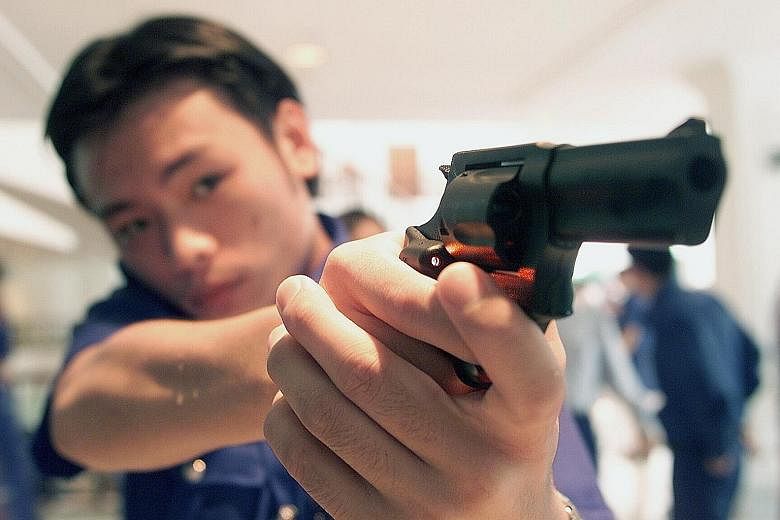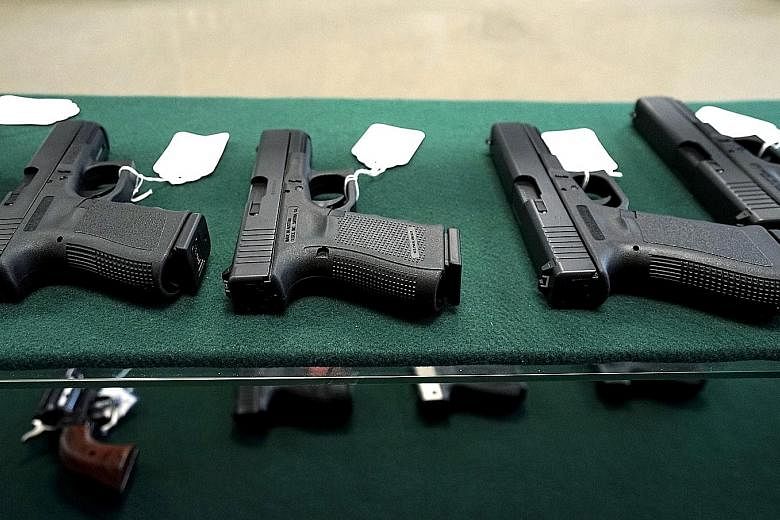Frontline officers in the Singapore Police Force (SPF) will soon be equipped with semi-automatic pistols - a change from the revolvers used now - giving them more powerful and accurate firearms to tackle heightened security threats.
While frontline officers are currently issued with a .38-calibre Taurus revolver and 10 rounds, pistols generally have a larger bullet holding capacity of up to 17 rounds on a standard magazine.
Revolvers and pistols are both handguns, but the former contains a revolving cylinder in which bullets are loaded, while the latter is fed by a magazine.
Sources say the police have been conducting trials of several pistol models for several months, and a new pistol will be put into use soon.
The Straits Times understands that a Central European 9mm pistol is among those field-tested here and is the front runner to be the new firearm for frontline officers.
-
Differences between the two weapons
-
REVOLVER
• Revolving cylinder
• Five to six rounds of ammunition, depending on model
• Fewer moving parts
• Less likely to jam
-
SEMI-AUTOMATIC PISTOL
• Uses magazines to hold ammunition
• One bullet enters chamber at a time, no revolving
• Up to 17 rounds, depending on model
• More moving parts, such as a spring that feeds a bullet into the chamber
• Allows for more stability and accuracy
• Higher chance of malfunction
In response to queries, an SPF spokesman said: "Given the heightened threat environment, the police have started to train and will equip officers in regular frontline units to use pistols."
Adding that more details on implementation will be revealed later, he said the police regularly review their equipment and that pistols are already used by selected units.
ST understands that these include its Security Command, which ensures the safety and security of Cabinet ministers and visiting foreign dignitaries, as well as some units from the Special Operations Command, which was formed to unite the police's elite tactical units.
But most officers are issued with a .38-calibre Taurus revolver, which plants a red dot on its target automatically. It reportedly replaced the Smith & Wesson .38 revolver in 2002. The Taurus revolver comes with a five-chambered cylinder and a "speed loader" - which allows the user to reload all chambers quickly at the same time.
Former police officer Adrian Tok said it is a good move to make the change to pistols because of their bigger capacity for ammunition.
Now a risk manager working in the security industry, Mr Tok said a 9mm pistol - referring to the approximate internal diameter of the barrel - with a standard magazine has 17 rounds, compared with the 10 rounds that officers generally carry.
Mr Timothy Ngui, 38, a member of the Singapore Rifle Association (SRA) who works in IT security, said semi-automatic pistols are safer.
"Generally, if you drop a semi- automatic pistol, it has safety mechanisms that prevent it from going off by accident," he said.
Pistols are also easier to use, he added, citing how with the different grip methods, users will find it easier to control recoil, increase stability and improve accuracy.
But retiree Kevin Leong, 66, a member of the SRA since the mid-1980s, said revolvers are "more reliable, mechanically speaking, and less likely to jam".
"That is one of the main reasons that people continue using revolvers when pistols offer so much more capacity in terms of ammunition," Mr Leong added.
Mr Tok said a revolver is "less subject to jamming" as it has fewer moving parts, but does not think the change will be an issue as officers can learn to overcome jamming or stoppages in pistols quickly.
"Times have changed, and the security threat has been changing. Such a change would help prepare the police force to deal with potential attacks in the future," he added.


